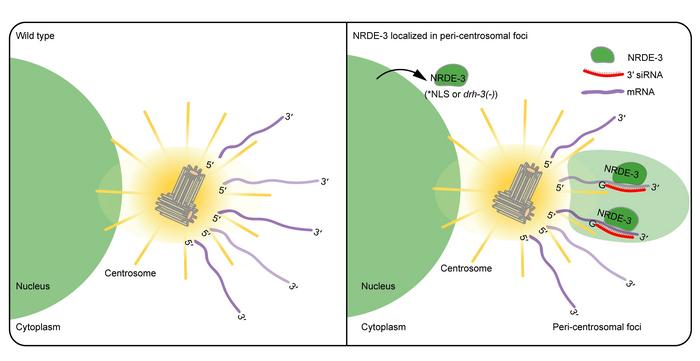
The centrosome is a critical component of cell biology, often dubbed the microtubule-organizing center, which plays a pivotal role in orchestrating cell division. In the realm of genetics and molecular biology, recent studies have turned the spotlight on centrosomal RNAs (cnRNAs), positing that these molecular entities could enable precise control over gene expression during cell division. However, the existence and function of cnRNAs within the context of the model organism C. elegans remains nebulous and warrants further investigation.
A compelling breakthrough arrived with research published in SCIENCE CHINA Life Sciences, which leveraged the nuclear Argonaute protein NRDE-3 as a reporter to uncover potential peri-centrosome-localized small interfering RNAs (siRNAs) within C. elegans. This study not only sheds light on an underexplored aspect of RNA biology but also emphasizes that the peri-centrosomal region could serve as a crucial platform for RNA interference (RNAi)-mediated gene regulation in biological systems.
The Argonaute protein NRDE-3 is garnering attention for its unique ability to bind siRNAs and subsequently engage with target RNAs featuring complementary sequences. Upon siRNA binding, NRDE-3 typically relocates to the nucleus where it interacts with pre-mRNAs or, under specific conditions, with pre-rRNAs, elucidating its pivotal role in the gene expression regulation landscape. By utilizing CRISPR/Cas9 gene-editing technology, the research team was able to engineer a GFP-tagged NRDE-3 knock-in that serves as a reporter molecule in oocytes, early embryos, and somatic cells while demonstrating notable enrichment within the nucleus of the cells.
Intriguingly, the study reveals that in specific C. elegans mutants associated with the small RNA pathway, such as eri-1, ergo-1, and drh-3, the localization of NRDE-3 underwent a significant transformation. Instead of its typical nuclear presence, NRDE-3 began to accumulate in peri-centrosomal foci during embryonic development. This striking observation suggests that the interaction between NRDE-3 and centriole proteins, as well as pericentriolar material (PCM) components, is essential for its peri-centrosomal localization.
The mechanism behind NRDE-3 accumulation in specific cellular regions was further analyzed, revealing a dependence on RdRP-synthesized 22G siRNAs and the PAZ domain of NRDE-3. These siRNAs and the PAZ domain were found to be crucial for the successful binding of siRNAs, thereby driving the distribution of NRDE-3 within the cellular architecture. Moreover, the studies elucidated that NRDE-3’s localization at the centrosome was not static; rather, it exhibited a dynamic behavior that was cell cycle-dependent, enriching at the peri-centrosomal region during metaphase.
Further investigations revealed that NRDE-3’s accumulation in the peri-centrosomal area was vital for the normal development of C. elegans. This emphasizes that peri-centrosomal RNAs may play indispensable roles beyond earthbound roles in gene regulation, potentially influencing outcomes in critical cellular processes such as mitosis. This dynamic localization points to a nuanced regulatory mechanism at play that could have larger implications for understanding gene expression during cell division.
While previous studies laid the groundwork for understanding RNA’s role within cellular processes, this current research marks a novel step toward elucidating the roles of localized siRNAs in C. elegans. The identification and characterization of peri-centrosome-localized siRNAs provide a foundation for future enquiries into their mechanisms and functions. These findings could catalyze a deeper understanding of RNA dynamics, contributing significantly to the broader fields of molecular biology and genetics.
The collaborative undertaking behind this research involved key contributions from Qile Jin, a Ph.D. student at the University of Science and Technology of China, along with Dr. Xuezhu Feng from Anhui Medical University, and other established researchers. Their combined efforts fostered meaningful advancements in the understanding of RNA biology, underpinned by robust support from various funding bodies, such as the National Natural Science Foundation of China.
As investigations continue, the outstanding question remains: Could the nuanced understanding of NRDE-3 and the intricacies of siRNA localization reveal untapped cellular mechanisms that govern gene regulation and development in larger biological contexts? The research community is eager to untangle these complexities, paving the way for future studies that might illuminate the multifaceted relationship between spatial RNA localization and gene expression dynamics.
The implications of this study extend beyond C. elegans and may resonate across other biological systems, inviting researchers to reassess our understanding of RNA localization mechanisms in a more global context. The fascinating interplay between RNA regulation and cellular architecture is a realm ripe for exploration and may yield insights that advance our comprehension of developmental biology, genetics, and even therapeutic strategies for diseases associated with aberrant gene regulation.
In conclusion, the exploration of NRDE-3 and its associated siRNAs offers a promising avenue for enriching our understanding of RNA-mediated gene regulation in cell biology. Future research endeavors will undoubtedly seek to unravel the intricate molecular networks that define RNA dynamics, elucidating their roles in ensuring cellular integrity and proper developmental pathways. As cellular biology continues to evolve, so too does our potential to harness these insights for innovative approaches in biomedicine and genetic engineering.
Subject of Research: Peri-centrosome-localized siRNAs in C. elegans
Article Title: Unraveling the Role of NRDE-3 and Peri-centrosomal siRNAs in C. elegans
News Publication Date: October 2023
Web References: DOI Link
References: SCIENCE CHINA Life Sciences
Image Credits: ©Science China Press
Keywords: NRDE-3, C. elegans, Small Interfering RNA, RNA Interference, Cell Division, Gene Expression, Centrosome, Gene Regulation, Molecular Biology, Developmental Biology.
Tags: C. elegans as a model organismcentrosomal RNAs and gene expressioncentrosome microtubule organizing centerCRISPR/Cas9 applications in geneticsgene regulation during cell divisionmolecular biology of centrosomesNRDE-3 Argonaute protein functionperi-centrosomal RNA localizationRNA biology research advancementsRNA interference mechanisms in cell divisionrole of siRNAs in RNA biologysmall interfering RNAs in C. elegans




